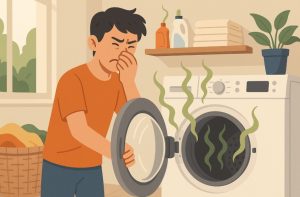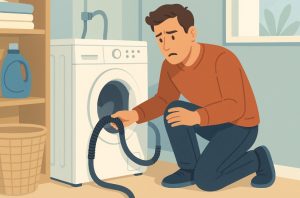Have you noticed your clothes coming out of the washing machine smelling less than fresh? It’s a frustrating situation that most people face at some point. Even though washing machines are meant to clean, they can easily become breeding grounds for mould, mildew, and bacteria if not maintained properly.
This often leads to unpleasant smells that can cling to your laundry and spread throughout your home. Understanding how to clean a smelly washing machine quickly and easily is essential for keeping it in top working condition. From natural solutions like vinegar and baking soda to key maintenance steps, there are straightforward ways to restore freshness.
In this guide, you’ll discover practical methods tailored for both front-load and top-load machines. Read on to learn exactly what causes the smell and how you can eliminate it, fast and with minimal effort.
Why Does Your Washing Machine Smell Bad?

Smelly washing machines are a common household issue, especially when they’re used frequently without regular cleaning. The odour is often caused by trapped moisture, soap residue, and organic matter that provide the perfect breeding ground for mould and bacteria. If you’ve ever opened your machine to a whiff of damp or mildew, you’re definitely not alone.
In many cases, the culprits behind the smell include:
- Detergent Overload: Using too much detergent leads to a sticky residue that builds up in the drum, pipes, and seal.
- Fabric Softener Build-Up: While it makes clothes feel soft, it can coat the internal parts of the machine, trapping grime.
- Neglected Seals and Gaskets: Front-loaders, in particular, hold water in the rubber gasket, which becomes mouldy over time.
- Rarely Run Hot Cycles: Most laundry is done at 30 to 40°C, which doesn’t kill bacteria effectively.
- Moisture Trapped Inside: Leaving the door or drawer shut after a wash allows moisture to linger, feeding bacteria.
Ignoring these early signs can not only affect the smell of your laundry but also lead to hygiene issues and long-term machine damage. The good news is that all of these causes are easily preventable with the right routine and a few deep cleaning strategies.
What Supplies Do You Need to Clean a Smelly Washing Machine?
Before diving into the cleaning process, make sure you’ve gathered all the right tools. Using basic household items, you can clean your washing machine thoroughly without relying on harsh chemicals or expensive cleaners.
Here’s what you’ll need:
- White Vinegar: A natural disinfectant that breaks down odours and bacteria.
- Baking Soda: Great for neutralising smells and scrubbing stubborn grime.
- Soft Cleaning Cloths or Microfibre Towels: For wiping surfaces clean.
- Old Toothbrush: Perfect for scrubbing small crevices and hard-to-reach areas.
- Sponge or Scrubbing Brush: To clean larger surfaces inside the drum or drawer.
- Spray Bottle: Mix a 1:1 solution of vinegar and water to clean rubber seals.
- Rubber Gloves: To protect your hands while cleaning dirty or mouldy parts.
- Shallow Tray or Bowl: For catching water when cleaning the filter.
These supplies are effective, budget-friendly, and safe to use regularly. They also avoid the need for commercial products that often contain harsh chemicals and artificial fragrances. With these tools ready, you’re all set for a deep clean that will leave your washing machine smelling fresh again.
How Do You Deep Clean the Washing Machine Drum?

The washing machine drum is the heart of the appliance, and it’s where much of the bad odour originates. A deep clean here is essential to restore your machine’s freshness and efficiency. Whether you have a top-loader or a front-loader, the process is nearly the same.
Start with an empty drum:
- For Top-Loaders: Pour 4 cups of white vinegar directly into the drum.
- For Front-Loaders: Add 2 cups of vinegar into the detergent dispenser.
Set the machine to the hottest and longest wash cycle. This will help dissolve detergent residue, kill bacteria, and flush away any grime built up inside. If your washer has a “tub clean” or “service wash” mode, use that setting.
For a stronger clean, add 1 cup of baking soda directly into the drum. This combination reacts mildly to break down gunk while neutralising lingering smells.
After the cycle ends, wipe the inside of the drum using a clean cloth to remove any loosened dirt. Make sure to dry the area thoroughly to prevent new mould growth. Regular deep cleaning like this, ideally once a month, ensures a fresher drum and longer-lasting appliance performance.
What’s the Best Way to Clean the Detergent Drawer?
The detergent drawer is often overlooked, yet it’s one of the dirtiest parts of a washing machine. Detergent and fabric softener residues can quickly build up, becoming a breeding ground for mould, mildew, and unpleasant odours. Start by removing the drawer completely. If you’re unsure how, refer to your machine’s user manual to avoid breaking any clips.
Once removed:
- Soak it in a bowl or sink filled with warm, soapy water for about 30 minutes.
- Use an old toothbrush to scrub all compartments thoroughly, especially the corners where mould often hides.
- Wipe the inside cavity of the drawer slot using a damp cloth or sponge to remove hidden grime.
Let the drawer dry fully before reinserting it. Doing this monthly will help reduce smells and prevent product build-up from entering your washing machine’s system.
Avoid using too much detergent or softener, as overuse contributes to faster build-up. Also, consider using liquid detergent as powders tend to leave more residue behind. A clean drawer keeps the washing process hygienic and improves water flow during cycles.
How Do You Clean the Rubber Seal Without Damaging It?
One of the most common sources of a smelly washer is the rubber door seal, especially on front-load machines. Its folds and crevices easily trap water, lint, hair, and detergent residue, a perfect recipe for mould growth.
To clean the rubber seal safely:
- Open the door wide and gently pull back the seal to expose hidden areas.
- Mix a solution of equal parts white vinegar and water in a spray bottle.
- Spray generously inside the folds of the rubber gasket.
- Use a soft toothbrush or cloth to gently scrub out mould, grime, and residue.
If you spot heavy mould, you may need to leave the vinegar solution to soak for a few minutes before scrubbing.
Once cleaned, dry the area with a microfibre cloth to remove all moisture. It’s important to avoid using abrasive cleaners or wire brushes here, as they can damage the rubber and reduce its ability to seal properly.
After every wash, make it a habit to wipe the gasket dry and leave the door slightly open. This small step dramatically reduces moisture retention and keeps smells at bay.
Where Is the Washing Machine Filter and How Do You Clean It?

When your washing machine still smells after a thorough clean, the filter is the next area to check. Hidden debris, lint, or even coins can get stuck in the drain pump filter and contribute to stubborn odours.
Locating the Drain Pump Filter
For most front-load machines, the filter is located at the bottom front behind a small panel. Open this panel carefully, and you’ll usually find a circular cap that twists out. For top-load machines, the filter may be inside the drum or beneath an access panel.
Safely Draining Water and Removing Debris
Before opening the filter:
- Turn off the machine and unplug it.
- Place a shallow tray or bowl under the filter area.
- Lay down towels to catch any spillage.
- Slowly twist open the filter cap in an anticlockwise direction to release trapped water.
- Once drained, remove any lint, hair, or foreign objects like coins or buttons.
Cleaning and Reassembling the Filter Area
Now clean the filter thoroughly under warm, soapy water. If there’s an impeller (small fan-like piece), rotate it gently to dislodge any stuck debris. Dry the filter with a towel and reinsert it, ensuring it’s sealed properly.
| Step | Description |
| Locate the Filter | Bottom front panel or behind drum (varies) |
| Prepare the Area | Unplug machine, lay towels, place tray |
| Remove Debris and Rinse | Remove filter, clear gunk, wash in warm water |
| Reassemble and Test | Dry filter, reinsert, and run short test cycle |
Cleaning the filter every few months helps keep the machine draining efficiently and reduces the chance of lingering smells.
How Can You Stop Washing Machine Smells from Coming Back?
Once you’ve done a deep clean, keeping smells away is all about good habits. Preventing odours is easier than dealing with them after they’ve taken hold.
Follow these simple tips to keep your washer smelling fresh:
- Leave the door and detergent drawer open after each wash to let air circulate and moisture evaporate.
- Wipe the drum and rubber seal after every few washes to stop mould from developing.
- Run a monthly hot wash with vinegar or a cleaning cycle if your machine has one.
- Avoid excess detergent. Use only the recommended amount to prevent build-up.
- Skip fabric softener or use white vinegar instead, which softens clothes without coating the machine.
By maintaining these small routines, your washing machine will stay cleaner for longer and continue to deliver fresh-smelling laundry every time.
Should You Use Store-Bought Cleaners or Natural Ingredients?

There’s a growing debate between using natural ingredients like vinegar and baking soda versus store-bought cleaners for tackling a smelly washing machine. Both have their strengths, and the right choice often depends on preference and sensitivity.
Pros and Cons of Natural Cleaners vs Chemical Options
| Type | Pros | Cons |
| Natural (Vinegar/Baking Soda) | Affordable, safe, eco-friendly | May need more frequent use for stubborn grime |
| Chemical (Tablets/Cleaners) | Quick results, specifically formulated | Can be harsh, more expensive, artificial scents |
Natural cleaners are ideal for regular maintenance and are often recommended in UK homes for being gentle on machines and the environment. However, for extremely dirty machines, a chemical cleaner may provide a quicker solution.
Why Vinegar and Baking Soda Are UK-Friendly Choices?
Vinegar is a staple in many UK households and is widely available at low cost. Combined with baking soda, it forms a mild fizzing action that lifts grime and neutralises odours. Unlike stronger chemicals, this mix won’t damage internal machine components or harm your pipes.
Additionally, using natural ingredients reduces the risk of allergic reactions or damage to septic systems, a major consideration in rural UK homes. For most users, alternating between both types of cleaners gives the best of both worlds.
What Maintenance Habits Keep Your Washing Machine Fresh Long-Term?
Maintaining a fresh-smelling washing machine isn’t just about occasional deep cleans. It’s the everyday habits that make the biggest difference in the long run. These small routines help preserve your washer’s lifespan and performance.
Here are habits to adopt:
- Always remove laundry promptly. Damp clothes left inside can create a musty smell.
- Dry the rubber seal and drum after every use to prevent mould growth.
- Use liquid detergent sparingly to avoid residue build-up.
- Run a monthly service wash at 60°C or higher with vinegar or cleaner.
- Check and clean the filter every couple of months.
- Leave doors and drawers ajar to ventilate the interior.
- Wipe external parts with a damp cloth weekly to keep dirt and detergent off surfaces.
These easy steps, done consistently, will ensure your machine continues to perform well without foul odours interrupting your laundry routine.
Can Smells Come from Somewhere Other Than the Machine?

If you’ve cleaned every part of the washing machine and there’s still a foul smell, it could be coming from external sources. Drainage and plumbing systems are often the hidden culprits behind persistent washing machine odours.
- Blocked Standpipe: This is the U-shaped pipe where the machine drains water. If clogged, it can back up water and release a sewer-like smell.
- Dirty Drain Hose: A build-up inside the drain hose can cause stagnant water to sit and smell bad.
- Incorrect Hose Placement: If the hose is inserted too far into the standpipe, it may prevent proper airflow and lead to foul odours.
To address this:
- Remove the drain hose and rinse it with warm water and vinegar.
- Use a drain cleaner to flush the standpipe if it’s partially blocked.
- Reconnect the hose, making sure it’s secured but not pushed too far down.
These extra checks can resolve lingering smells that regular cleaning won’t eliminate, ensuring your laundry room smells as fresh as your clothes.
Conclusion
Cleaning a smelly washing machine doesn’t have to be overwhelming. With the right tools and a straightforward routine, you can remove odours and prevent them from returning. Whether it’s scrubbing the rubber seal, cleaning the filter, or running a monthly hot wash with vinegar, every small effort adds up.
Staying on top of regular maintenance not only keeps your clothes fresh but also extends the life of your appliance. Make these habits part of your routine, and enjoy a cleaner, fresher laundry experience every time you press start.
FAQs
How often should I clean my washing machine to avoid smells?
Once a month is ideal to prevent the build-up of mould, detergent residue, and odour.
Can I use bleach instead of vinegar to clean my washer?
Yes, but vinegar is safer and more environmentally friendly for routine use.
Why does my clean washing machine still smell?
Hidden build-up in the filter or drain pipe might still be causing bad odours.
Is it safe to mix vinegar and baking soda in the drum?
Yes, the mixture helps break down grime naturally and is safe for the machine.
What’s the easiest way to clean a top-loading washer?
Run a hot cycle with vinegar and wipe down the drum and lid after cleaning.
Do washing machine cleaning tablets work better than vinegar?
They work faster but can be harsher and more costly compared to natural options.
How can I clean my washing machine filter if it’s not removable?
Use a toothbrush or pipe cleaner to gently remove debris from the area.







